Abstract
The Internet of Things (IoT) is evolving rapidly, enabling more new applications than ever before. Some radio systems in the IoT space used to connect things with things operate at the 863–928 MHz frequency band (e.g., LoRa, ISM). IoT wireless devices at 900 MHz need an efficient antenna to send data into the cloud, and ensure range and long battery life. Moreover, the antenna should be easy to use across different device sizes. In this regard, antenna booster technology is proposed, which relies on a tiny element called an antenna booster, able to excite radiation currents on the ground plane of the IoT device. The antenna booster in this paper is only 12 mm × 3 mm × 2.4 mm (height), representing only ~λ/30 at 863 MHz. Such an antenna booster is reactive across the 863–928 MHz frequency range and, thus, a matching network is needed. The paper first proposes a matching network on a 120 mm × 60 mm ground plane. Afterward, an analysis is carried out to find the set of different ground plane sizes where the same matching network as the one used for the 120 mm × 60 mm ground plane can be reused, ensuring an S11 < −6 dB. The goal is to find a map representing a cluster of ground planes where the same antenna system can be used (the same antenna booster and the same matching network) to simplify the design of IoT devices embedding antenna boosters. The analysis is addressed using MoM (Method of Moments) electromagnetic software (IE3D) and validated through measurements. Results indicate that a broad set of device sizes can reuse the same matching network with the same antenna booster, thus, simplifying and accelerating the design of IoT devices since no adjustment is needed on the antenna system.
1. Introduction
Due to the tremendous growth of the internet, the goal of having everything connected has become a reality thanks to the Internet of Things. The IoT enables an unimaginable number of applications fostering the increase in IoT devices. IoT devices are provided with many sensors such as air quality, humidity, light, temperature, position, vibration, etc. Data captured from sensors must be sent to the cloud or other devices. One of the most fundamental parts of these devices, if not the most, is the antenna, which enables connectivity, range, and battery life.
Among the different IoT spectra, the frequency range of 863–928 MHz has been chosen where some radios are allocated, such as LoRa. LoRa is a modulation that allows communication between sensors and gateways over long distances (from a few kilometers in urban scenarios to hundreds in line-of-sight conditions) with a very low power consumption thanks to the LoRAWAN protocol [1,2,3,4,5,6]. However, the present analysis results can be extended to other protocols working at around 900 MHz, such as ISM (Industrial, Scientific, and Medical).
Strategies to design single-band compact antennas at 900 MHz can be found in the literature [7,8,9,10,11]. In [7], an antenna for the USA LoRa band is presented. The concept uses a two × two artificial magnetic surface which increases the size of the antenna system, making it challenging to integrate into a small IoT device. Another proposal covers the 433 MHz and 915 MHz or 868 MHz bands with an antenna using a microstrip patch based on a fractal model [8]. However, the antenna size is big (~9 cm × 7 cm) and, again, difficult to be integrated into an IoT device. Other studies achieve a multiband antenna design covering the 433 MHz and 868 MHz bands in a real IoT device, with a total efficiency of −6 dB and −4.5 dB, respectively. The design methodology for this antenna is based on the use of two lumped components inserted in a radiating element [9]. A dual-band Planar Inverted-F Antenna (PIFA) at the unlicensed 868 and 915 MHz ISM bands for IoT was presented, where the antenna featured a size of 40 mm × 5 mm × 5.35 mm [10]. Other studies compare an antenna conventionally manufactured on a PCB (FR4) and a printed antenna using jetting technology on a PC + ABS (Polycarbonate and Acrylonitrile Butadiène Styrène) polymeric substrate [11]. Other progresstoward designing compact antennas for IoT has appeared in the literature [12,13,14,15,16,17,18,19,20,21,22,23,24,25].
A different approach is addressed in this paper using antenna boosters. In essence, it is a tiny (~λ/30) non-resonant element called an antenna booster that allows operation at the desired frequency band with the addition of a matching network [21]. The paper focuses on designing a matching network for an antenna booster at 863–928 MHz for different ground plane sizes representing different device sizes. This is intended to facilitate the design phase while developing IoT devices, particularly those operating around 900 MHz. The objective is to analyze how a matching network can be reused for different ground plane sizes. The purpose of reusing the same matching network is to simplify the design of IoT devices since the same matching network with the same antenna booster can be used for a large set of devices, avoiding the customization of either the antenna part or the matching network. The objective is to analyze how the solution can be reused without any hardware adjustment of the matching network. The reason is that many IoT designers are experts on RF and electronics, not on antennas. They require a solution that works for any form factor minimizing or even without any tuning of the matching network.
The LoRa 863 MHz and 928 MHz frequency band is chosen to include the European to the North American bands. Therefore, a matching network is designed to achieve a reflection coefficient with an S11 ≤ −6 dB between 863 MHz and 928 MHz. The matching network comprises only two lumped elements to obtain a simple and efficient antenna system.
The paper is divided as follows: Section 2 briefly explains the antenna booster technology. Section 3 shows the design of the reference matching network and discusses the performance of such a matching network for different ground plane sizes. Section 4 analyses the radiation properties. Section 5 discusses some representative cases of IoT devices. Section 6 presents the conclusions.
2. Antenna Booster Technology
Antenna booster technology relies on a non-resonant electrically small element, called an antenna booster (~λ/30), and a specific matching network to cover one or more frequency bands [26,27,28,29,30,31,32,33].
The antenna booster in this paper is, essentially, a 3D conductive parallelepiped. Technically, the antenna booster excites current modes on the ground plane of the PCB (printed circuit board) of the IoT device. Thus, the radiating structure is not the antenna booster itself but the ground plane of the device [33]. Consequently, the performance is not related to the size of the antenna booster but is going to be directly proportional to the dimensions of the device [27].
Since the antenna booster is non-resonant, finding a suitable matching network makes it possible to match the antenna booster to work at the desired frequency, maximizing power radiated to space or the received power from space. Figure 1 illustrates the behavior of the antenna booster when there is no matching network. In the absence of the matching network, the whole frequency range of interest (863–928 MHz) is very poorly matched (S11 ~ −1 dB). As shown in Figure 1, impedance without a matching network is capacitive. For example, the impedance is 33.4-j199 Ω and 35.8-j184 Ω at 863 MHz and 928 MHz, respectively.
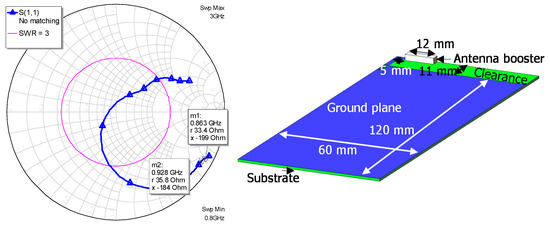
Figure 1.
S11 for a 12 mm × 3 mm × 2.4 mm (height) antenna booster on a 120 mm × 60 mm ground plane without a matching network featuring a reactive impedance. The substrate is 1 mm thick with εr = 4.15 and tanδ = 0.017. The antenna booster is modeled as a conductive parallelepiped with a conductivity of σ = 5.9 × 107 S/m.
For this study, a 12 mm × 3 mm × 2.4 mm (height) antenna booster was shown (Figure 1). Although it was very poorly matched, its position at the corner of the ground plane excited radiating currents; therefore, the simulated radiation efficiency (ηr) was 90% at 900 MHz. As a result, a low-loss matching network was added to the antenna booster for matching purposes; therefore, in the end, the total efficiency ηt (ηt = ηr·(1 − |S11|2)) could be high, as shown in the next section, since the matching network could minimize S11 while keeping low losses. Low matching network losses were achieved using high-quality factor (Q) lumped capacitors and inductors. As far as the antenna booster’s location is concerned, the corner typically provides a better bandwidth [26].
Since the ground plane of the device affected impedance, the S11 of the antenna system changed. Hence, the bandwidth was different depending on the ground plane size L × W. As a rough reference, L ~ 0.37 λ maximizes the bandwidth considering rectangular ground planes (L > W). For example, at 900 MHz, L ~ 120 mm provides an optimum bandwidth [33,34].
The following section analyzed how the same matching network designed for a reference case (120 mm × 60 mm ground plane) could be reused for different ground plane sizes while keeping an S11 ≤ −6 dB across 863–928 MHz. To explore how the same matching network could be reutilized for different ground plane sizes, a set of 361 sizes was tested, from 20 mm × 20 mm to 200 mm × 200 mm, with a step of 10 mm.
3. Results
3.1. Reference Matching Network
A reference matching network for the antenna booster on the 120 mm × 60 mm ground plane matched the reactive impedance. To obtain this matching network, the Cadence Microwave Office software was selected, including the real S-parameters of the lumped components of the matching network. The input impedance of the antenna booster on the ground plane without any matching network was obtained through electromagnetic simulation using the IE3D MoM (Method of Moment) software.
The chosen reference matching network shown in Figure 2 consisted of a 16 nH parallel inductance (LQW18AN16NG80) and a 33 nH series inductance (LQW18AN33NG80). Both inductances were SMD components of size 1.6 mm × 0.8 mm (0603 SMD), with a tight tolerance of ±2% and high Q (Q > 85). Note that the matching network was obtained through a matching network synthesis tool, which automatically found the topology and the values of the matching network once the reactive impedance was given [26]. However, in this single-band case, the matching network could have been obtained following the classic matching network theory [35].
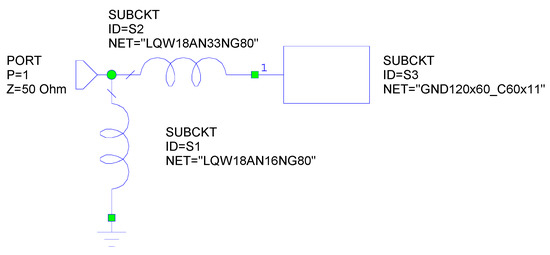
Figure 2.
Result of the matching network with Murata’s commercial components. Inductors were SMD 0603 type with a Q > 85 at the 863–960 MHz frequency range. The series inductor was 33 nH, and the shunt inductor was 16 nH. The rectangle represents the impedance of the antenna booster on the 120 mm × 60 mm without any matching network.
It is worth mentioning that the same antenna booster on the same 120 mm × 60 mm ground plane could operate at other frequencies by changing the matching network. For example, Ref. [36] shows a multiband matching network working from 824 to 960 MHz and 1710 to 2690 MHz. This allowed the flexibility of the antenna booster technology to tame the frequency bands of operation through a simple matching network design.
3.2. Measurement
To verify its correct operation in the targeted frequency bands, the S11 was measured. It can be observed that an S11 < −6 dB across the whole 863–928 MHz frequency range (Figure 3).
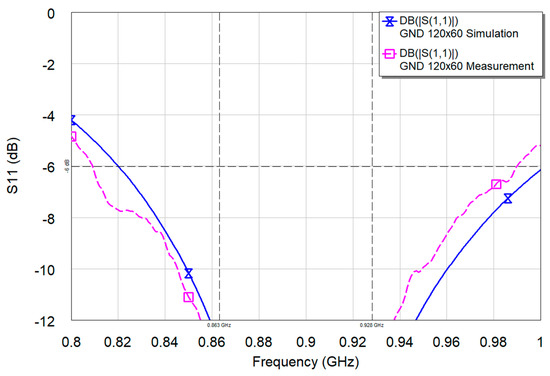
Since the bandwidth exceeded 863–928 MHz, the matching network may still be operative for other ground plane sizes different than the 120 mm × 60 mm ground plane reference. The following section found out the set of the ground planes where the same matching network could be reused. This simplifies the design of IoT devices since the wireless designer does not need to make any adjustments to the antenna system. Thus, the solution becomes more plug-and-play for a broad set of devices. Moreover, the same antenna booster was reused for all ground plane cases without selecting or designing a new antenna for each ground plane.
For the measured analysis, the same configuration as the simulated scheme (Figure 1) was followed (Figure 4): a 12 mm × 3 mm × 2.4 mm antenna booster, a 120 mm × 60 mm ground plane, and a matching network with two lumped components. A 50 Ω micro-coaxial transmission line terminated with a 50 Ω SMA connector was included to test the S11 and total efficiency. The input impedance of the 12 mm × 3 mm × 2.4 mm antenna booster without a matching network was non-resonant in the 863–928 MHz frequency range (Figure 1). The antenna booster could be approximated as a conductive parallelepiped of 12 mm × 3 mm × 2.4 mm size with σ = 5.9 × 107 S/m as the one shown in Figure 1, or as an electromagnetic model available for CST Microwave Studio [37], where the antenna reference was the RUN mXTEND™ (Ignion, Barcelona, Spain) antenna booster.
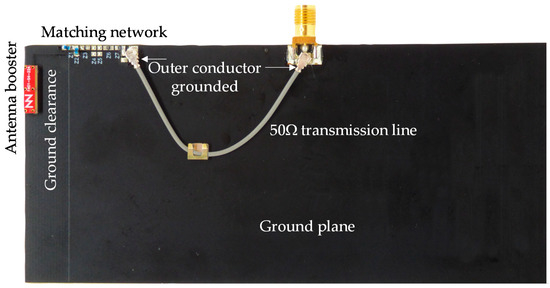
Figure 4.
The 12 mm × 3 mm × 2.4 mm antenna booster on a 120 mm × 60 mm ground plane and the matching network with two components: series Z1 = 33 nH and shunt Z2 = 16 nH (Figure 2).
Simulated and measured total efficiencies were compared, showing an excellent agreement (Figure 5). The average total efficiency across 863–928 MHz was 87.3% and 87.4% for the simulated and measured cases, respectively. This represented a difference of only 0.004 dB. Thanks to this good agreement of both the S11 and total efficiency, simulated results for different ground plane sizes shown next were reliable.
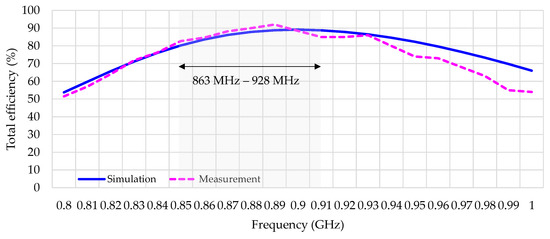
Figure 5.
Simulated and measured total efficiency ηt for the antenna booster on a 120 mm × 60 mm ground plane. Total efficiency was measured in an anechoic chamber (MVG Startlab-18) using 3D pattern integration.
3.3. On the Reuse of the Reference Matching Network for Other Ground Plane Sizes
This section aimed to determine the set of ground plane sizes, where the same reference matching network obtained in the previous section could be reused while keeping an S11 ≤ −6 dB across 863–928 MHz. The collection of ground planes satisfying such an S11 condition was denominated hereafter as the cluster.
For this study, 361 ground planes of different dimensions were simulated with IE3D (Figure 6). The tested ground planes covered a space from 20 mm × 20 mm to 200 mm × 200 mm, with a difference of 10 mm between them. Then, using the Cadence Microwave Office software, the behavior of the reference matching network for all the previously simulated ground planes was tested.
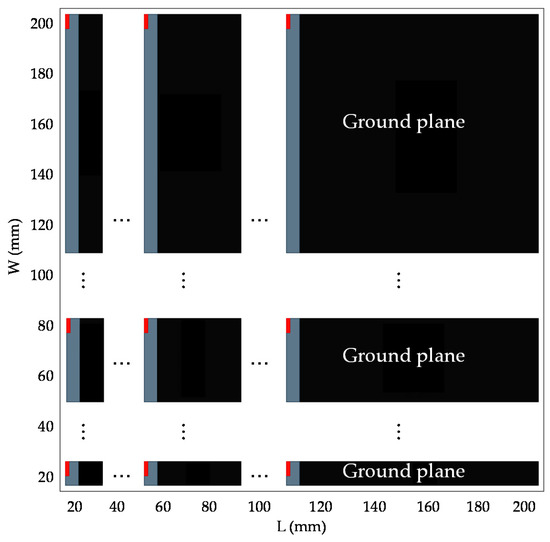
Figure 6.
Different ground plane sizes are from the smallest (20 mm × 20 mm) to the biggest (200 mm × 200 mm). The simulation space includes 361 ground plane sizes. The antenna booster (12 mm × 3 mm × 2.4 mm) is shown in red. In all cases, the feeding line to feed the antenna booster was the same as well as the position of the antenna booster, as shown in Figure 1.
The worst reflection coefficient within the 863–928 MHz was recorded for each ground plane to perform this analysis. If the worst S11 across the frequency band was better than −6 dB, this meant that all frequencies within the band were well-matched below −6 dB. A map was obtained by mapping this worst value for each ground plane size (Figure 7). The warmer colors show poor matching, while the blueish colors show the best-matched ground planes. Thanks to the contour shown in Figure 7, the −6 dB boundary was observed, and within that contour, the cluster of the ground planes had an S11 ≤ −6 dB across 836–930 MHz.
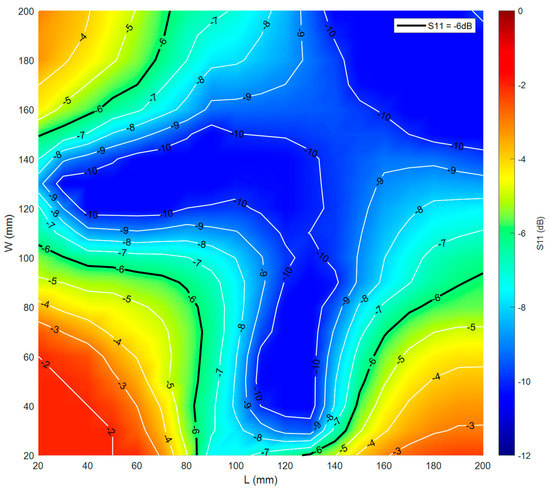
Figure 7.
The cluster of ground planes with an S11 ≤ − 6 dB corresponds to those cases within the −6 dB contour line. L and W represent the length and width of the ground plane, respectively.
Concerning the behavior of the cluster, it had a cross shape in which the central values presented better matching than the values at the corners. The matching network was designed for a ground plane length of 120 mm and a width of 60 mm. Therefore, all ground planes with a length or width similar to these dimensions would have a good matching. This cluster had a diagonal symmetry, where the center of this symmetry lay on the diagonal formed by the ground planes that were equal in length and width. There were three areas off-cluster (top left, bottom left, and right) discussed in Section 3.4.
Of the 361 different ground plane possibilities, a total of 241 ground planes featured an S11 ≤ −6 dB. This cluster meant that 66.8% of the cases feature an S11 ≤ −6 dB with the same matching network.
The cluster information is valuable since it revealed that the same matching network could be applied across any ground plane belonging to the cluster. For example, a ground plane of 90 mm (length) × 60 mm (width), which was within the cluster, would feature an S11 < −6 dB with the same matching network as the 120 mm × 60 mm reference ground plane.
3.4. Total Efficiency Analysis of the Cluster
As shown in Section 3.2, the simulated and measured total efficiency were in good agreement. As a result, as discussed in this section, we could rely on the simulated total efficiencies for other ground plane sizes.
To simulate the total efficiency for the different ground plane sizes, an analysis was carried out with IE3D software. Efficiency was represented as a percentage; the higher the percentage, the better the efficiency. These efficiency calculations considered the losses of the two inductors of the matching network as well as the substrate on which the ground plane was printed, which had a tanδ = 0.017, a finite conductivity of the ground plane, and the antenna booster, which was modeled as a 3D conductive box with σ = 5.9 × 107 S/m. Then, the total efficiency was averaged across 863–928 MHz and represented, including the contour defining the cluster (Figure 8).
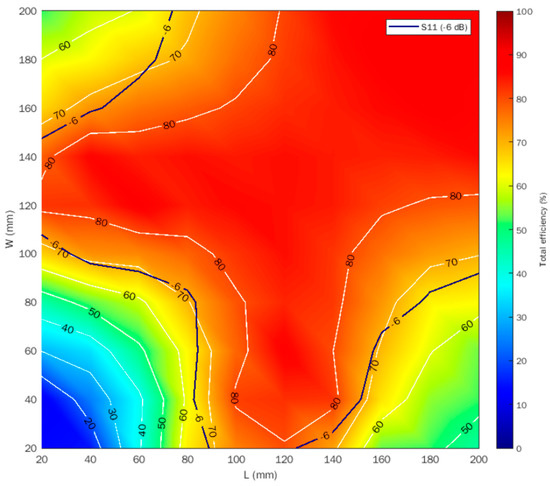
Figure 8.
Simulated total efficiency for the different ground plane sizes L × W using the same 12 mm × 3 mm × 2.4 mm antenna booster and matching network for all cases. The −6 dB contour line defines the cluster boundary of the cases with an S11 ≤ −6 dB across 863–928 MHz.
Figure 8 reflects the efficiency of displaying the best values with warm colors and the worst with cold colors. As seen in most ground planes within the cluster, the total efficiency was approximately above 70%.
From Figure 8, it could be concluded that for the ground planes within the cluster (S11 ≤ −6 dB), the total efficiency was above 70%. It is also relevant that the off-cluster location presented an acceptable total efficiency, such as in the case of the corner with long lengths or large widths. However, there was a critical zone (the bottom left corner) where the efficiency dropped as the size of the ground plane decreased due to mismatching, but also because the radiation efficiency decreased. Therefore, it was hard to obtain high-efficiency values even with good matching in the critical zone.
3.5. Off-Cluster Discussion
It is worth noting that off-cluster ground planes can achieve enough bandwidth to cover 863–928 MHz, but with a different matching network than the reference one. This was true for the off-cluster area at the top left and bottom right corners (either a considerable length or large width), where a similar L-type matching network could be designed to match the antenna system. For example, for the top left corner, a 47 nH series inductor (connected to the booster) with a shunt 2.7 pF capacitor provided a bandwidth wide enough to cover 863–928 MHz. Similarly, a 48 nH series inductor (connected to the antenna booster) with a shunt 1.8 pF capacitor offered enough bandwidth for the right bottom corner to cover the same frequency range.
However, the bottom left corner (small ground planes) required special treatment since the achievable bandwidth decreased as the ground plane area decreased. Some cases could be matched for this zone (transition and critical), but more than two components were needed. In this case, a broadband matching network with two lumped components in addition to the matching network could enhance the inherent bandwidth of the antenna system by a factor of ~2.4 [38,39] and up to 4.5 with more components considering an SWR = 3 [40].
The potential bandwidth for each off-cluster ground plane could be computed according to the input impedance information [26]—(Figure 9). In brief, the potential bandwidth was the achievable bandwidth that could be obtained with a simple matching network with two lumped components [41]. It was interesting to observe a first area, called the transition zone. This area is defined as ground plane cases with a potential bandwidth larger than 3% and smaller than 7.2%. The 7.2% is the required bandwidth to cover the 863–928 MHz frequency range. Therefore, a more sophisticated matching network would be needed if the potential bandwidth was less than 7.2%. In this case, a broadband matching network comprising three components or more may increase the potential bandwidth by a factor of 2.4 for S11 = −6 dB. Since a broadband matching can typically enhance the bandwidth by a factor of 2.4, a broadband matching circuit could achieve a 7.2% bandwidth for a 3% antenna system. Finally, the critical area is defined as cases with less than a 3% potential bandwidth. In this area, a passive matching network was not suitable, and a reconfigurable matching network could be the solution to cover the whole 863–928 MHz frequency range [42].

Figure 9.
Potential bandwidth for several ground planes. The critical area is defined as cases with less than 3% potential bandwidth. A transition zone is defined as having a potential bandwidth larger than 3% and smaller than 7.2%. In this area, a broadband matching network (three or more lumped components) could achieve the 7.2% to cover the 863–928 MHz frequency band.
4. About Radiation Properties
Besides impacting impedance, the ground plane also had implications on the radiation properties (Figure 10). The current distribution was computed at 900 MHz for the reference 120 mm × 60 mm ground plane and for the four ground planes at each corner of the domain: 20 mm × 20 mm, 20 mm × 200 mm, 200 mm × 20 mm, and 200 mm × 200 mm.
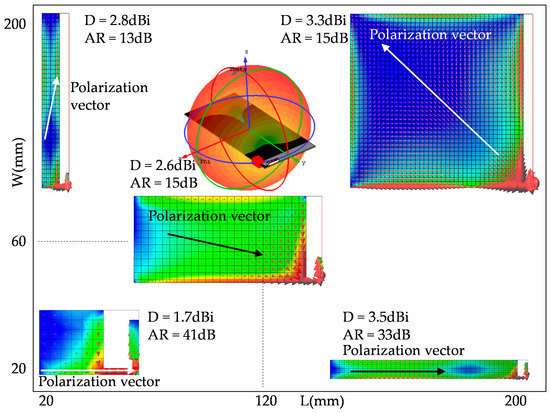
Figure 10.
Simulated current distribution, directivity, and the axial ratio at 900 MHz for the 20 mm × 20 mm, 20 mm × 200 mm, 200 mm × 20 mm, 120 mm × 60 mm, and 200 mm × 200 mm ground planes. AR is the axial ratio for θ = 0° (direction perpendicular to the ground plane). The arrows indicate the direction of the polarization vector. The 3D radiation pattern is represented in dB with a dynamic range of 30 dB at 900 MHz for the 120 mm × 60 mm ground plane.
Since all cases featured small sizes in terms of the wavelength, radiation patterns were low directive and similar to a half-wavelength dipole: directivity was 1.7 dBi for the 20 mm × 20 mm ground plane case, 2.6 dBi for the reference case, and 3.3 dBi for the largest ground plane. The polarization in the direction of maximum radiation was linear with an axial ratio (AR) larger than 13 dB. The direction of the polarization vector changed according to the current distribution on the ground plane. The polarization was aligned with the horizontal axis for the 20 mm × 20 mm and 200 mm × 20 mm ground planes. For the reference ground plane (120 mm × 60 mm), the polarization was slanted 20° with respect to the horizontal axis. This was due to vertical currents on the ground plane. For the 20 mm × 200 mm, the polarization was almost vertical. Finally, the polarization for the 200 mm × 200 mm ground planes was slanted 45°. This was because the intensity of the current distribution was symmetric along the horizontal and vertical axis since the antenna booster was located at the corner of the square ground plane.
Although matching impedance could be controlled by a matching network and the position of the antenna booster (typically, the corners are stated to obtain a higher bandwidth and efficiency [26]), radiation pattern properties were determined by the size of the ground plane with respect to the operating wavelength. From a practical perspective, due to the sizes, if the ground planes for IoT devices are small in terms of the wavelength (e.g., the largest ground plane analyzed here was 200 mm × 200 mm representing 0.6 λ at 900 MHz), radiation patterns will be quasi-isotropic, which is convenient for scenarios where the angle of arrival of the incoming electromagnetic signal is not known. A highly directional antenna may be preferred for point-to-point links, which is less common in IoT applications.
5. Discussion
In a bid to further highlight the benefit of reusing the same matching network (Figure 2), four different cases were studied: the reference case with a 120 mm × 60 mm ground plane, a thinner case with a 120 mm × 20 mm ground plane such as a remote control, a small device with a 90 mm × 40 mm ground plane such as a tracker, and a 200 mm × 200 mm ground plane such as a smart meter (Figure 11).
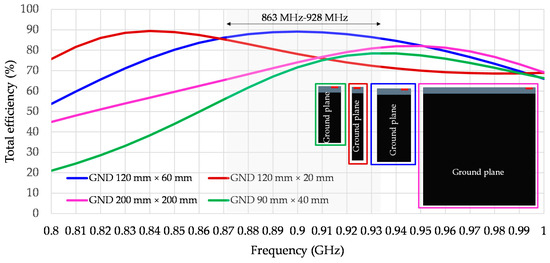
Figure 11.
Simulated total efficiency for different cases embedding a 12 mm × 3 mm × 2.4 mm antenna booster with the same matching network as Figure 2.
All four cases were within the cluster (Figure 7), ensuring an S11 < −6 dB across 863–928 MHz. The averaged total efficiencies were 87.3%, 79.6%, 72.2%, and 67.1% for the 120 mm × 60 mm, 120 mm × 20 mm, 200 mm × 200 mm, and 90 mm × 40 mm ground planes, respectively. As demonstrated in the previous section, the total efficiency was competitive if the device had a ground plane belonging to the cluster. Logically, further tuning the matching network could increase the total efficiency to have a symmetrical response as the 120 mm × 60 mm reference case. However, reusing the same matching network avoided any adjustment of the components and hence, the antenna booster solution followed the concept of plug, play, and forget. As a result, the solution is easy to use and embed in a wide set of IoT devices featuring different form factors since no customization on the antenna system is needed.
Finally, the antenna booster solution was compared to other antenna designs operating at 900 MHz (Table 1). Considering an imaginary parallelepiped that included the antenna, the average volume of five solutions in the prior art was 1294 mm3. In contrast, the antenna booster was only 86.4 mm3, which was 15 times smaller in volume. In terms of the bandwidth, the solutions presented in [21,24] featured a similar bandwidth compared to the antenna booster system. However, even for the smallest solution of the prior art with a similar bandwidth [24], the volume was 993 mm3, which was more than ten times larger in volume than the antenna booster component.

Table 1.
Comparison of several single-band antennas operating at 900 MHz.
6. Conclusions
A 12 mm × 3 mm × 2.4 mm antenna booster and a matching network with two lumped components operated at 863–928 MHz across different ground planes with the same antenna booster and components of the matching network without any further customization. Out of a space of ground planes between 20 mm × 20 mm and 200 mm × 200 mm, up to 66.8% (the cluster) could reuse the same matching network with an S11 ≤ −6 dB with an average total efficiency of around 70% and beyond.
Regarding off-cluster areas, the two regions for either considerable lengths or large widths could obtain a high enough bandwidth to cover 863–928 MHz, although with a different matching network. For the off-cluster encompassing small ground planes, broadband matching networks enhanced the bandwidth enough to operate at 863–928 MHz. However, for ground planes of less than 60 mm × 60 mm, some sacrifice in terms of S11 should be accepted, or a reconfigurable matching solution should be considered.
The proposed method showed in this paper could be a reference to studying the robustness of a particular antenna booster with a matching network for a specific frequency range as a function of the ground plane size.
With the proposed design methodology based on antenna booster technology, the design of IoT devices is alleviated, since the antenna system is compact and usable across many device sizes without customizing the antenna system.
Author Contributions
All authors (J.G., A.A. and J.A.) contributed to the conception and development of the results. All authors have read and agreed to the published version of the manuscript.
Funding
This research received no external funding.
Conflicts of Interest
The authors declare no conflict of interest.
References
- Semtech. Semtech. 2019. Available online: https://www.semtech.com/lora/what-is-lora (accessed on 2 May 2021).
- LoRa Alliance. What Is LoRaWAN® Specification. 2019. Available online: https://lora-alliance.org/about-lorawan/ (accessed on 5 May 2021).
- LoRa Alliance. About LoRa Alliance. 2019. Available online: https://lora-alliance.org/about-lora-alliance/ (accessed on 5 May 2021).
- Kim, D.-H.; Lee, E.-K.; Kim, J. Experiencing LoRa Network Establishment on a Smart Energy Campus Testbed. Sustainability 2019, 11, 1917. [Google Scholar] [CrossRef] [Green Version]
- LoRa Alliance. What Is It? A Technical Overview of LoRa® and LoRaWAN®. 2015. Available online: https://lora-alliance.org/resource_hub/what-is-lorawan/ (accessed on 5 May 2021).
- Stokking, J. LoRaWAN fundamentals. In Proceedings of the Things Industries Conference 2021, Online, 25–29 January 2021. [Google Scholar]
- Shin, G.; Park, J.; Park, T.; Yoon, I. Compact 900-MHz LoRa Band Antenna on a Low-Profile AMC Surface. In Proceedings of the 2019 International Symposium on Antennas and Propagation (ISAP), Xi’an, China, 27–30 October 2019; pp. 1–2. [Google Scholar]
- Chuma, E.L.; Iano, Y.; Bravo, L.L.R. Compact antenna based on fractal for IoT sub-GHz wireless communications. In Proceedings of the 2017 SBMO/IEEE MTT-S International Microwave and Optoelectronics Conference (IMOC), Aguas de Lindoia, Brazil, 27–30 August 2017; pp. 1–5. [Google Scholar] [CrossRef]
- Ferrero, F.; Toure, M.B. Dual-band LoRa Antenna: Design and Experiments. In Proceedings of the 2019 IEEE Conference on Antenna Measurements & Applications (CAMA), Bali, Indonesia, 23–25 October 2019; pp. 243–246. [Google Scholar] [CrossRef]
- Diallo, K.; N’Gom, A.; Diallo, A.; Ribero, J.M.; Dioum, I.; Ouya, S. Efficient dual-band PIFA antenna for the Internet of Things (IoT). In Proceedings of the 2018 IEEE Conference on Antenna Measurements & Applications (CAMA), Vasteras, Sweden, 3–6 September 2018; pp. 1–4. [Google Scholar] [CrossRef]
- Delfaut, C.; Vuong, T.; Reverdy-Bruas, N.; Curtil, D.; Venet, C. New potential of a direct printed LoRa antenna. In Proceedings of the 2019 IEEE International Symposium on Antennas and Propagation and USNC-URSI Radio Science Meeting, Atlanta, GA, USA, 7–12 July 2019; pp. 1779–1780. [Google Scholar] [CrossRef]
- Lin, Z.; Lin, M.; de Cola, T.; Wang, J.-B.; Zhu, W.-P.; Cheng, J. Supporting IoT with Rate-Splitting Multiple Access in Satellite and Aerial-Integrated Networks. IEEE Internet Things J. 2021, 8, 11123–11134. [Google Scholar] [CrossRef]
- Sabban, A. Small New Wearable Antennas for IoT, Medical and Sport Applications. In Proceedings of the 2019 13th European Conference on Antennas and Propagation (EuCAP), Krakow, Poland, 31 March–1 April 2019; pp. 1–5. [Google Scholar]
- Koga, Y.; Kai, M. A Transparent Double Folded Loop Antenna for IoT Applications. In Proceedings of the 2018 IEEE-APS Topical Conference on Antennas and Propagation in Wireless Communications (APWC), Cartagena, Columbia, 10–14 September 2018; pp. 762–765. [Google Scholar] [CrossRef]
- De Gómez, M.E.; Álvarez, H.F.; González, C.G.; Valcarce, B.P.; Olenick, J.; Las-Heras, F. Ultra-Thin Compact Flexible Antenna for IoT Applications. In Proceedings of the 2019 13th European Conference on Antennas and Propagation (EuCAP), Krakow, Poland, 31 March–1 April 2019; pp. 1–4. [Google Scholar]
- Bichara, R.M.; Asadallah, F.A.; Constantine, J.; Awad, M. A Folded Miniaturized Antenna for IoT Devices. In Proceedings of the 2018 IEEE Conference on Antenna Measurements & Applications (CAMA), Vasteras, Sweden, 3–6 September 2018; pp. 1–3. [Google Scholar] [CrossRef]
- Xiao, B.; Wong, H.; Yeung, K.L. Penta-band Dual-fed Smart Glasses IoT Antenna. In Proceedings of the 2020 14th European Conference on Antennas and Propagation (EuCAP), Copenhagen, Denmark, 15–20 March 2020; pp. 1–4. [Google Scholar] [CrossRef]
- Shao, Z.; Fang, Y.; Zhang, Y.P. Compact Dual-Band Antenna with Broadside and Conical Radiation Patterns for NB-IoT Applications. In Proceedings of the 2020 IEEE International Symposium on Antennas and Propagation and North American Radio Science Meeting, Montreal, QC, Canada, 5–10 July 2020; pp. 281–282. [Google Scholar] [CrossRef]
- Zhuo, L.; Han, H.; Shen, X.; Zhao, H. A U-shaped wide-slot dual-band broadband NB-IoT antenna with a rectangular tuning stub. In Proceedings of the 2020 IEEE 4th Information Technology, Networking, Electronic and Automation Control Conference (ITNEC), Chongqing, China, 12–14 June 2020; pp. 123–128. [Google Scholar] [CrossRef]
- Hussain, R.; Abou-Khousa, M.; Khan, M.U.; Sharawi, M.S. A Compact Sub-1 GHz IoT Antenna Design with Wide Tuning Capabilities. In Proceedings of the 2021 15th European Conference on Antennas and Propagation (EuCAP), Dusseldorf, Germany, 22–26 March 2021; pp. 1–3. [Google Scholar] [CrossRef]
- Pandey, A.; Deepak, M.V. Inset Fed Miniaturized Antenna with Defected Ground Plane for LoRa Applications. In Third International Conference on Computing and Network Communications; Elsevier: Amsterdam, The Netherlands, 2020. [Google Scholar]
- Trinh, L.H.; Nguyen, T.Q.K.; Phan, D.D.; Tran, V.Q.; Bui, V.X.; Truong, N.V.; Ferrero, F. Miniature Antenna for IoT Devices Using LoRa Technology. In Proceedings of the International Conference on Advanced Technologies for Communications, Quy Nhon, Vietnam, 18–20 October 2017; pp. 170–172. [Google Scholar]
- Lee, S.R. PCB Pattern Antenna of 920 MHz Band for Marine IoT Services. J. Adv. Navig. Technol. 2019, 23, 430–436. [Google Scholar]
- Serio, A.D.; Buckley, J.; Barton, J.; Newberry, R.; Rodencal, M.; Dunlop, G.; O’Flynn, B. Potential of Sub-GHzWireless for Future IoT Wearables and Design of Compact 915 MHz Antenna. Sensors 2018, 18, 22. [Google Scholar] [CrossRef] [PubMed] [Green Version]
- Wanpare, W.; Paisal, A.; Chalermwisutkul, S. A Compact 923MHz Monopole Antenna for LoRaWAN IoT Applications. In Proceedings of the 2020 International Conference on Power, Energy, and Innovations (ICPEI 2020), Chiangmai, Thailand, 14–16 October 2020. [Google Scholar]
- Anguera, J.; Andújar, A.; Mestre, G.; Rahola, J.; Juntunen, J. Design of Multiband Antenna Systems for Wireless Devices Using Antenna Boosters. IEEE Microw. Mag. 2019, 20, 102–114. [Google Scholar] [CrossRef]
- Anguera, J.; Picher, C.; Bujalance, A.; Andújar, A. Ground Plane Booster Antenna Technology for Smartphones and Tablets. Microw. Opt. Technol. Lett. 2016, 58, 1289–1294. [Google Scholar] [CrossRef]
- Anguera, J.; Andújar, A.; Puente, C.; Mumbrú, J. Antennaless Wireless Device Capable of Operation in Multiple Frequency Regions. Patent Application WO2010/015364, 31 July 2009. [Google Scholar]
- Anguera, J.; Andújar, A.; Puente, C.; Mumbrú, J. Antennaless Wireless Device. U.S. Patent US8203492,B2, 19 June 2012. [Google Scholar]
- Andújar, A.; Anguera, J.; Puente, C. Ground Plane Boosters as a Compact Antenna Technology for Wireless Handheld Devices. IEEE Trans. Antennas Propag. 2011, 59, 1668–1677. [Google Scholar] [CrossRef]
- Anguera, J.; Andújar, A.; García, C. Multiband and Small Coplanar Antenna System for Wireless Handheld Devices. IEEE Trans. Antennas Propag. 2013, 61, 3782–3789. [Google Scholar] [CrossRef]
- Anguera, J.; Toporcer, N.; Andújar, A. Slim Booster Bars for Electronic Devices. U.S. Patent US9960478,B2, 1 May 2018. [Google Scholar]
- Anguera, J.; Andújar, A. Ground Plane Contribution in Wireless Handheld Devices using Radar Cross Section Analysis. Progress Electromagn. Res. M 2012, 26, 101–114. [Google Scholar] [CrossRef] [Green Version]
- Kivekis, O.; Ollikainen, J.; Lehtiniemi, T.; Vainikainen, P. Connection between the chassis length, bandwidth, efficiency, and SAR of internal handset antennas. In Proceedings of the Twelfth International Conference on Antennas and Propagation, 2003 (ICAP 2003). (Conf. Publ. No. 491), Exeter, UK, 31 March–3 April 2003; Volume 2, pp. 735–738. [Google Scholar] [CrossRef]
- Pozar, D. Microwave Engineering, 4th ed.; John Wiley & Sons Inc.: Hoboken, NJ, USA, 2011. [Google Scholar]
- Anguera, J.; Andújar, A.; Leiva, J.L.; Mateos, R.M. Antenna Boosters: Easy Design of IoT Devices. In Proceedings of the European Conference on Antennas and Propagation 2021, Düsseldorf, Germany, 22–26 March 2021. [Google Scholar]
- Ignion. RUN mXTENDTM. Available online: https://ignion.io/product/run-mxtend/ (accessed on 5 April 2022).
- Anguera, J.; Puente, C.; Borja, C.; Font, G.; Soler, J. A systematic method to design single-patch broadband microstrip patch antennas. Microw. Opt. Technol. Lett. 2011, 31, 185–188. [Google Scholar] [CrossRef]
- Lopez, A.R. Review of narrowband impedance-matching limitations. IEEE Antennas Propag. Mag. 2004, 46, 88–90. [Google Scholar] [CrossRef]
- Fano, R.M. Limitations on the broadband matching of arbitrary impedances. J. Franklin Inst. 1960, 249, 57–83. [Google Scholar] [CrossRef] [Green Version]
- Rahola, J. Bandwidth potential and electromagnetic isolation: Tools for analyzing the impedance behaviour of antenna systems. In Proceedings of the 2009 3rd European Conference on Antennas and Propagation, Berlin, Germany, 23–27 March 2009; pp. 944–948. [Google Scholar]
- Anguera, J.; Andújar, A.; Leiva, J.L.; Massó, O.; Tonnesen, J.; Rindalsholt, E.; Brandsegg, R.; Gaddi, R. Reconfigurable Multiband Operation for Wireless Devices Embedding Antenna Boosters. Electronics 2021, 10, 808. [Google Scholar] [CrossRef]
Publisher’s Note: MDPI stays neutral with regard to jurisdictional claims in published maps and institutional affiliations. |
© 2022 by the authors. Licensee MDPI, Basel, Switzerland. This article is an open access article distributed under the terms and conditions of the Creative Commons Attribution (CC BY) license (https://creativecommons.org/licenses/by/4.0/).